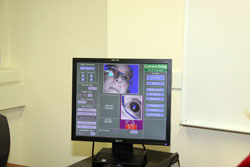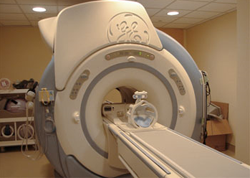Eye Movement Laboratory for the Study of Reading Process and Visual Attention
 The EyeLink 1000 is a high speed and high accuracy eye tracking system especially suitable for reading and perception experiments, where stimuli are presented via computer, and very high spatial and temporal resolution is needed.
The EyeLink 1000 is a high speed and high accuracy eye tracking system especially suitable for reading and perception experiments, where stimuli are presented via computer, and very high spatial and temporal resolution is needed.
This lab is designed to do eye tracking when sequences of textual or graphic stimuli are presented via a computer display. The focus of this system is full control over the experiment by the system software. This enables on-line manipulation of the stimuli presented based on real-time performance data, as well as data storing for later analysis.
The EyeLink 1000 system acts as a multipurpose eye movement measurement tool. It can be used with two different mounting options: with a chin or forehead rest (Head Supported) or without any head support (Remote / Head Free). In every case, the system provides unprecedented sampling rate, spatial resolution and accuracy for the given application.











 Functional MRI (fMRI) offers the opportunity to measure human brain activity in a non-invasive manner, while participants are engaged in various tasks. To date, it provides one of the most effective ways to localize and assess the brain's activation patterns in response to a large range of tasks, and has provided invaluable insights into human brain function in the sensory, emotional, and cognitive domains.
Functional MRI (fMRI) offers the opportunity to measure human brain activity in a non-invasive manner, while participants are engaged in various tasks. To date, it provides one of the most effective ways to localize and assess the brain's activation patterns in response to a large range of tasks, and has provided invaluable insights into human brain function in the sensory, emotional, and cognitive domains. fMRI measures brain activity by detecting changes in cerebral blood flow. When neurons activate in the brain, oxygenated blood levels in that region are increased and detected by the scanner. This allows us to localize brain structures that are involved in different cognitive tasks both on the local and network levels, and to associate various brain activity patterns to psychological processes, personality traits, and neural pathologies among other things. Our imaging lab focuses on the neural underpinnings of diverse cognitive processes, and primarily on attention, perception, memory, and emotions.
fMRI measures brain activity by detecting changes in cerebral blood flow. When neurons activate in the brain, oxygenated blood levels in that region are increased and detected by the scanner. This allows us to localize brain structures that are involved in different cognitive tasks both on the local and network levels, and to associate various brain activity patterns to psychological processes, personality traits, and neural pathologies among other things. Our imaging lab focuses on the neural underpinnings of diverse cognitive processes, and primarily on attention, perception, memory, and emotions.
 A system by Mindware Technology with a multichannel BioNex 8-slot chassis that allows psychophysiological data collection from participants.
A system by Mindware Technology with a multichannel BioNex 8-slot chassis that allows psychophysiological data collection from participants.